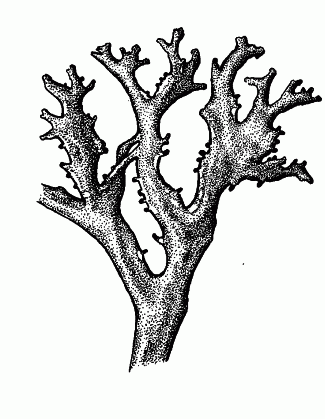Click on the image below to view an
expanded illustration for this species.

|
General:
Small to large stratified foliose lichens, corticate above and below, sorediate or not, lobes rather closely appressed to semi-erect or erect, short to more often elongate, averaging to 0.5–10 (–12) mm wide, thin to somewhat thick, occasionally bearing protruberant marginal pycnidia or cilia. Upper surface brownish, blackish, or brightly coloured; lower surface coloured alike with upper surface, often lacking rhizines. Medulla white (rarely yellow). Photobiont green. Apothecia located along lobe margins, disc brown or black; spores simple, spherical or ellipsoid, colourless, 8 per ascus.
Notes: Thirty-eight species of Cetraria are reported for North America. Nineteen of these occur in B.C. As presently delimited, Cetraria is a heterogeneous genus. Although several species groups are segregated from it as distinct genera (e.g. Asahinea, Cetrelia, Esslingeriana, Masonhalea, Platismatia and Vulpicida), a number of other species and species groups also deserve generic rank. Recently Hale (1987) transfered some of these to Tuckermannopsis. This disposition, however, seems more nomenclatural than taxonomic and is not followed here. Also not accepted here (pending further study) is the separate genus Allocetraria (Randlane and Saag 1992).
Species description:
Upper surface essentially dark: olive-green, brown or blackish AND Soredia absent; true isidia also absent AND Growing over bark, wood, earth or humus AND Over earth, humus or occasionally on branches at bases of shrubs; pseudocyphellae present or absent over lower surface; lobes generally elongate, margins often bearing short projections and/or cilia AND Lobes averaging to more than 2 mm wide, often concave; pseudocyphellae present or absent AND Lobe margins lacking cilia (Note: marginal projections may, however, be present, these averaging to 0.1–1 mm long); lobes at most dark brown; distribution various AND Medulla KC+ reddish; alpine; northernmost regions
Reactions:
All spot tests negative.
Contents:
Lichesterinic acid and two unidentified substances.
Source: Lichens of British Columbia |

